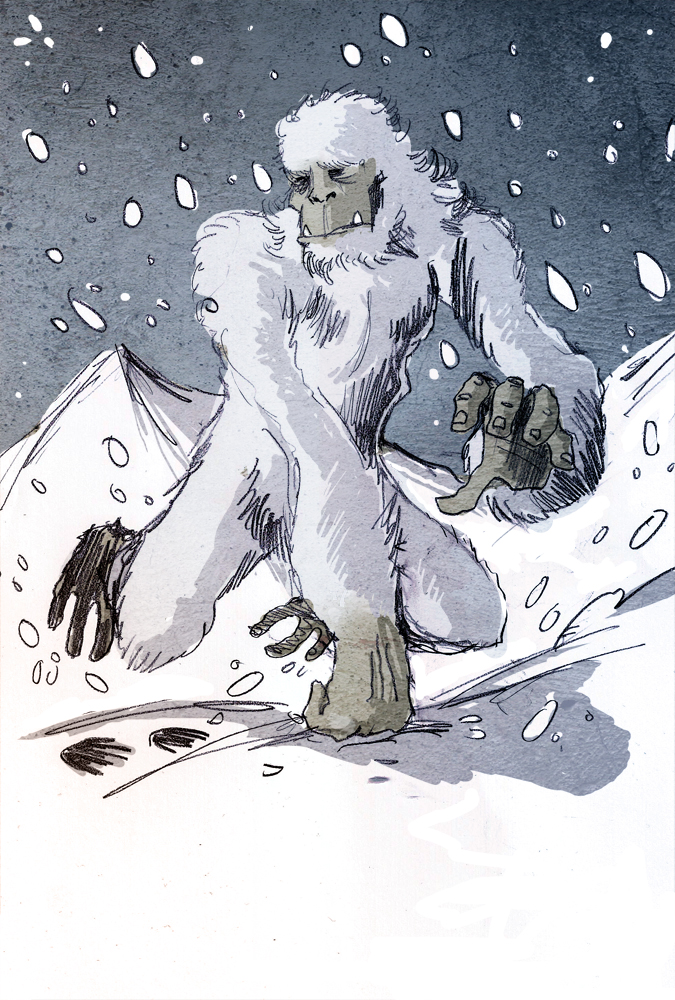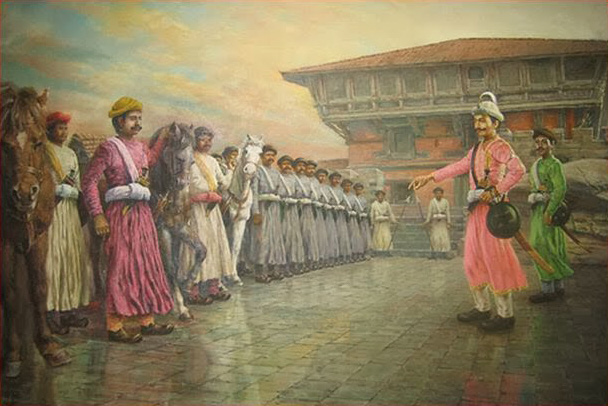|
Budhahang
Budhahang (Nepali:बुढाहाङ) was a Kirat Rai king of Khalsa territory of Eastern Nepal. His palace was located in the region currently known as Ankhisalla and Chintang. It is said that the Khalsa area of Dhankuta District included Chhintang, Khoku, Ankhisalla, Chungmang Pakhribas, Phalate, Sanne, Muga, Leguwa, Belhara and Bhirgaon were under the Khalsa state before the Unification of Nepal. www.nepalnewscenter.com Biography The identity of the king is contradictory. The parents of Budhahang are also not clear. According to Kājimān Kandaṅvā (1993: 121), the name of Budhahang's father was Rakhansingh hang. Budahang was the second siblings among four brothers - Cinbassa, Rakhanbassa, Rumbassa, Rukumbassa (in order of seniority). Budhahang had several children, the actual numbers are however unclear. It is agreed that he had seven daughters namely * Sureksi * Rakaksi * Tigumhaŋma or Chintang Devi, * Jagadeo * Sɨŋciri * Luŋciri * Piccadaŋma B ... [...More Info...] [...Related Items...] OR: [Wikipedia] [Google] [Baidu] |
Rai People
The Rai are an ethnolinguistic group belonging to the Kirati people, Kirat family and primarily Tibeto-Burman languages, Tibeto-Burman linguistic ethnicity. They mainly reside in the eastern parts of Nepal, the Indian states of Sikkim, West Bengal (predominantly Darjeeling district, Darjeeling and Kalimpong district, Kalimpong Hills) and in south western Bhutan. The Rais are a set of groups, one of the cultivating tribes of Nepal. They inhabited the area between the Dudh Koshi and Tamur River in Nepal. They claim that their country alone is called (Kirat Autonomous State, Kiratdesh), and they call themselves Rai. In modern times, they have spread over Nepal, Sikkim and West Bengal. Rai are also known as "Jimdar" and in some places as "Khambu." "Jim" means "land" because they cultivated "Jim" or land, the Rais return cultivation as their traditional occupation. Herbert Hope Risley, H. H Risley treats the Rais and Jimdar the as synonymous with the Khambus, but most of the Rais now ... [...More Info...] [...Related Items...] OR: [Wikipedia] [Google] [Baidu] |
Nepalese Folklore
Nepalese folklore is a diverse set of mythology and traditional beliefs held by the Nepali people. Folk beliefs * Banjhakri and Banjhakrini, supernatural shamans of the forest. * ''Bir'', a demon *'' Boksi'', a witch * Budhahang, legendary Kirati king who could stop movement of sun * ''Chhauda'', a child ghost * Kichkandi, type a female ghost. * Lakhey and Majipa Lakhey, types of demon. * ''Masan'', a demon *'' Murkatta'', a headless ghost with eyes and mouth in chest * Yeti, an ape-like creature purported to inhabit the mountains of Nepal. See also * Culture of Nepal The culture of Nepal encompasses the various cultures belonging to the 125 distinct ethnic groups present in Nepal. The culture of Nepal is expressed through music and dance; art and craft; folklore; languages and literature; philosophy and re ... References {{Nepal-stub Nepalese folklore Nepalese culture ... [...More Info...] [...Related Items...] OR: [Wikipedia] [Google] [Baidu] |
Chintang Devi Temple
Chintang Devi temple (छिन्ताङ देवी) is a Hindu and Kirati temple located in Dhankuta, Nepal. The temple is en route to the ancient pilgrimage site of Barahakshetra at the confluence of the Saptakoshi River. The temple is also known by the name of Jalpadevi Temple. The temple derives its name from Chintang, one of the seven daughter of Budhahang. Any women after mensuration (generally 10 years or older) are not allowed to enter the temple. A festival is organized in the full moon of Baisakh in the temple. A kirat The Kirati people, also spelled as Kirant or Kiranti, are a Sino-Tibetan ethnic group. They are peoples of the Himalayas, mostly the Eastern Himalaya extending eastward from Nepal to North East India (predominantly in the Indian state of Sikkim ... priest looks after the temple. References {{Nepal-stub Hindu temples in the Province No. 1 Buildings and structures in Dhankuta District ... [...More Info...] [...Related Items...] OR: [Wikipedia] [Google] [Baidu] |
Leguwa
Leguwa is a village development committee in Dhankuta District in the Kosi Zone of eastern Nepal. At the time of the 1991 Nepal census The 1991 Nepal census was a widespread national census conducted by the Nepal Central Bureau of Statistics. Working with Nepal's Village Development Committees at a district level, they recorded data from all the main towns and villages of each ... it had a population of 4206 people living in 796 individual households. References Populated places in Dhankuta District {{Dhankuta-geo-stub ... [...More Info...] [...Related Items...] OR: [Wikipedia] [Google] [Baidu] |
Kirati People
The Kirati people, also spelled as Kirant or Kiranti, are a Sino-Tibetan ethnic group. They are peoples of the Himalayas, mostly the Eastern Himalaya extending eastward from Nepal to North East India (predominantly in the Indian state of Sikkim and the northern hilly regions of West Bengal, that is, Darjeeling and Kalimpong districts). Etymology Kirat means lion-hearted people or people of a lion nature. It also means mountain people.The word Kirata is a derivation from Kirati or Kiranti to name the group of people in Eastern Nepal and Northeast India. History The Kirat ("Kiranti") are an ancient people who have been associated with the history of Nepal for thousands of years. Sources from the Kathmandu Valley describe the Kiratas as early rulers there whom may have been cattle-herding tribes. During the Kirat Dynasty Kathmandu was called Yela-khom. According to one of the legendary accounts, the primitive kiratis living in Nepal also lived in Sikkim. They are descenden ... [...More Info...] [...Related Items...] OR: [Wikipedia] [Google] [Baidu] |
Unification Of Nepal
The Unification of Nepal, also known as Expansion of Gorkha Kingdom, officially began in 1743 AD (1799 BS) after King Prithvi Narayan Shah of Gorkha launched an aggressive annexation campaign seeking to broaden his own kingdom's border. After conquering the Nepal Mandala, which consisted of the different city-states of the Kathmandu, Lalitpur, Kirtipur and Bhaktapur, Shah moved his hilly capital in Gorkha to the fertile and wealthy city of Kathmandu and adopted the name Nepal for the entire Gorkha Empire. The Shah dynasty would go on to expand the various warring kingdoms that once occupied parts of present-day Nepal into a nation-state that stretched up to the Sutlej River in the west and Sikkim-Jalpaiguri in the east. Before usage by the Gorkha Empire, the Kathmandu Valley was known as Nepal after the Nepal Mandala, the region's Nepal Bhasa name. Invasion of Nuwakot Prithvi Narayan Shah's annexation campaign began with the nearby kingdom of Nuwakot. Nuwakot marked the eas ... [...More Info...] [...Related Items...] OR: [Wikipedia] [Google] [Baidu] |
Prithivi Narayan Shah
Maharajadhiraj Prithvi Narayan Shah (1723–1775) ( ne, श्री ५ बडामहाराजाधिराज पृथ्वीनारायण शाह देव) was the last ruler of the Gorkha Kingdom and first monarch of the Kingdom of Nepal (also called ''Kingdom of Gorkha''). Prithvi Narayan Shah started the unification of Nepal. Shah proclaimed the newly unified Kingdom of Nepal as ''Asal Hindustan'' ("Real Land of Hindus") due to North India being ruled by the Islamic Mughal Empire, Mughal rulers. He also referred to the rest of Northern India as ''Mughlan'' (Country of Mughal Empire, Mughals). Prithvi Narayan Shah is considered as the Father of the Nation in Nepal. Early years Prithvi Narayan Shah was born Preterm birth, prematurely on 11 January 1723 as the first child of Nara Bhupal Shah and Kaushalyavati Devi in the Gorkha Palace. Prince Prithvi Narayan Shah's education began at age five through the appropriate ceremony. At that time, the responsi ... [...More Info...] [...Related Items...] OR: [Wikipedia] [Google] [Baidu] |
Unification Of Nepal
The Unification of Nepal, also known as Expansion of Gorkha Kingdom, officially began in 1743 AD (1799 BS) after King Prithvi Narayan Shah of Gorkha launched an aggressive annexation campaign seeking to broaden his own kingdom's border. After conquering the Nepal Mandala, which consisted of the different city-states of the Kathmandu, Lalitpur, Kirtipur and Bhaktapur, Shah moved his hilly capital in Gorkha to the fertile and wealthy city of Kathmandu and adopted the name Nepal for the entire Gorkha Empire. The Shah dynasty would go on to expand the various warring kingdoms that once occupied parts of present-day Nepal into a nation-state that stretched up to the Sutlej River in the west and Sikkim-Jalpaiguri in the east. Before usage by the Gorkha Empire, the Kathmandu Valley was known as Nepal after the Nepal Mandala, the region's Nepal Bhasa name. Invasion of Nuwakot Prithvi Narayan Shah's annexation campaign began with the nearby kingdom of Nuwakot. Nuwakot marked the eas ... [...More Info...] [...Related Items...] OR: [Wikipedia] [Google] [Baidu] |
Bhirgaun
Bhirgaun (also spelled Bhirgaon) is a village development committee in Dhankuta District in the Kosi Zone of eastern Nepal. At the time of the 1991 Nepal census The 1991 Nepal census was a widespread national census conducted by the Nepal Central Bureau of Statistics. Working with Nepal's Village Development Committees at a district level, they recorded data from all the main towns and villages of each ... it had a population of 4413 people living in 792 individual households. References Populated places in Dhankuta District {{Dhankuta-geo-stub ... [...More Info...] [...Related Items...] OR: [Wikipedia] [Google] [Baidu] |
Belhara
Belhara is a village development committee in Dhankuta District in the Kosi Zone of eastern Nepal. At the time of the 1991 Nepal census The 1991 Nepal census was a widespread national census conducted by the Nepal Central Bureau of Statistics. Working with Nepal's Village Development Committees at a district level, they recorded data from all the main towns and villages of each ... it had a population of 4857 people living in 874 individual households. The center part of it is called Guthitaar Bazzar. The main source of income of this area is tomato, capsicum and orange production. References Populated places in Dhankuta District {{Dhankuta-geo-stub ... [...More Info...] [...Related Items...] OR: [Wikipedia] [Google] [Baidu] |
Muga, Nepal
Muga is a village development committee in Dhankuta District in the Kosi Zone of eastern Nepal. At the time of the 1991 Nepal census The 1991 Nepal census was a widespread national census conducted by the Nepal Central Bureau of Statistics. Working with Nepal's Village Development Committees at a district level, they recorded data from all the main towns and villages of each ... it had a population of 4101 people living in 738 individual households. References Populated places in Dhankuta District {{Dhankuta-geo-stub ... [...More Info...] [...Related Items...] OR: [Wikipedia] [Google] [Baidu] |
Shahidbhumi Rural Municipality
Shahidbhumi ( ne, सहीदभूमि गाउँपालिका) is a rural municipality (gaunpalika) out of four rural municipality located in Dhankuta District of Province No. 1 of Nepal. There are a total of 7 municipalities in Dhankuta in which 3 are urban and 4 are rural. According to Ministry of Federal Affairs and Local Development Khalsa Chhintang Sahidbhumi has an area of and the total population of the municipality is 18730 as of Census of Nepal 2011. To form this new Rural Municipality Chhintang, Khoku and Ankhisalla were merged, which previously were all separate Village development committee (local level administrative villages). Fulfilling the requirement of the new Constitution of Nepal 2015, Ministry of Federal Affairs and Local Development replaced all old VDCs and Municipalities into 753 new local level body (Municipality A municipality is usually a single administrative division having corporate status and powers of self-government or jur ... [...More Info...] [...Related Items...] OR: [Wikipedia] [Google] [Baidu] |




